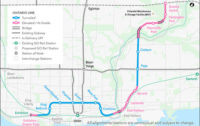The Ontario government will be investing $1.03 billion in transit, roads and bridges over the next few years, with approximately $575 million of that amount earmarked for the first extension of Toronto’s subway system in four years. Details were announced in its budget unveiled March 23.  Click here to view map
Click here to view map
Toronto city and transit officials believe the province’s decision will help kick start a long awaited 8.7-kilometer, six-station extension of its underutilized Spadina subway line to York University in the northwest part of the city. From there, the route would extend into neighboring York Region and connect with the regional transit system.
But matching one-third funding shares from the federal and municipal governments are required before the project can move forward, says Tom Middlebrook, Toronto Transit Commission general engineer “So far we haven’t seen that [funding] and will don’t know all the details.”
Not only would the subway line be the first to cross into another municipality, it would be the first new subway project since Toronto’s 6.4-kilometre five-station Sheppard subway opened in 2002. The $743-million project took eight years to build and was the city’s first new transit line in 17 years.
“We had quite an impressive record of building from the early 1950s to 1980. But we’ve only built eight kilometers of track in 25 years.”
Environmental assessments of the proposed route have been completed and submitted to the Ontario Ministry of the Environment. Studies have shown existing annual ridership of 30 million passengers, plus 10 million new riders would use the extension by 2021, says Middlebrook.
Building the extension would make commuting considerably easier for York University’s approximately 65,000 students, faculty and staff, says Lorna Marsden, university president and vice chancellor.
“The subway extension will be a tremendous boost to York University students and our community. It will ease gridlock both on and off campus, reduce pollution, and preserve the academic core by providing a much-needed public transit alternative for the tens of thousands of people who travel here every day.”


Post a comment to this article
Report Abusive Comment